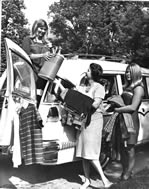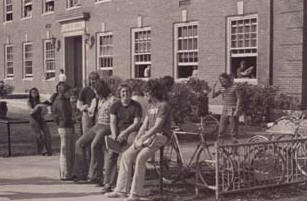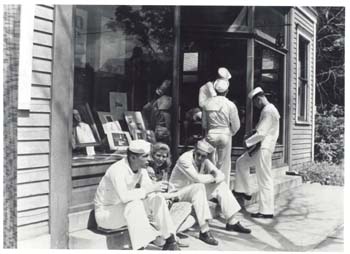
|
Pages: 1 2 3 4 5 6 7 8 9 10 Next >> The
outbreak of the war in Europe in September 1939 had little impact
at DePauw or other American colleges, where both academic and social
life continued for the most part on its usual course. The intellectual
climate on campus reflected the political isolationism then so prevalent
in much of the nation, particularly in the Middle West. It is true
that since the mid-1930s increasing attention was being paid to
current events in Europe and Asia in chapel and convocation programs
as well as in certain courses in the college curriculum. International
affairs, however, probably seemed very remote from the interests
of many undergraduates of that time, who were presumably more concerned
with the immediate problems of economic recovery at home and jobs
after graduation.
______________________________
Japan's
surprise attack on the United States naval base at Pearl Harbor
in Hawaii on December 7, 1941 and the subsequent declaration of
war on the Axis Powers by Congress brought greater changes to the
campus than any previous military crisis. The immediate response
was an outburst of patriotic display along with jittery nerves and
apprehension about the future, particularly among men eligible for
military service. The 1942 Mirage reported this reaction: "The
Stars and Stripes were uncovered and rolled out the windows; rifles
were snatched from corners and platoons were maneuvered about East
College...Everywhere students swapped rumors and prognostication;
everywhere radios chanted communiques." By February 1942 a
local national emergency committee was formed, later joined by a
committee of defense, both consisting of representatives of the
student body and the faculty and staff. The ordinary round of student
activities and social life gradually gave way to community service,
farm chores, paper and scrap-metal collection drives, first-aid
classes, and accelerated study programs.
______________________________
Later
DePauw was host to another, quite different Naval training program.
The Navy V-12, a college training program for qualified students
preparing to be commissioned as Naval Reserve officers, arrived
in July 1943 and remained until October 1945. Again the resident
faculty was responsible for most of the curriculum, which consisted
in large part of academic subjects studied in regular college classes
with civilian students. Under the command of Lt. Commander William
B. Dortch, the 400 apprentice seamen in the Navy V-12 program lived
in Rector and Lucy Rowland Halls. Their number was later increased
to 600 after the last V-5 unit departed. Eligible to participate
in athletics, these Navy students made it possible for DePauw to
continue in intercollegiate sports competition during the course
of the war. Altogether the two Navy training programs played a large
role in helping the university survive at a time when there were
few civilian male students available. "We have served the nation,"
President Wildman said in summing up DePauw's experience with the
Naval units, "in helping to give training to its officer personnel
and we have in turn been helped through some extremely difficult
years by their presence on campus." |
Depauw University e-history | E-mail comments to: archives@depauw.edu
|
People,
Events & Traditions |






